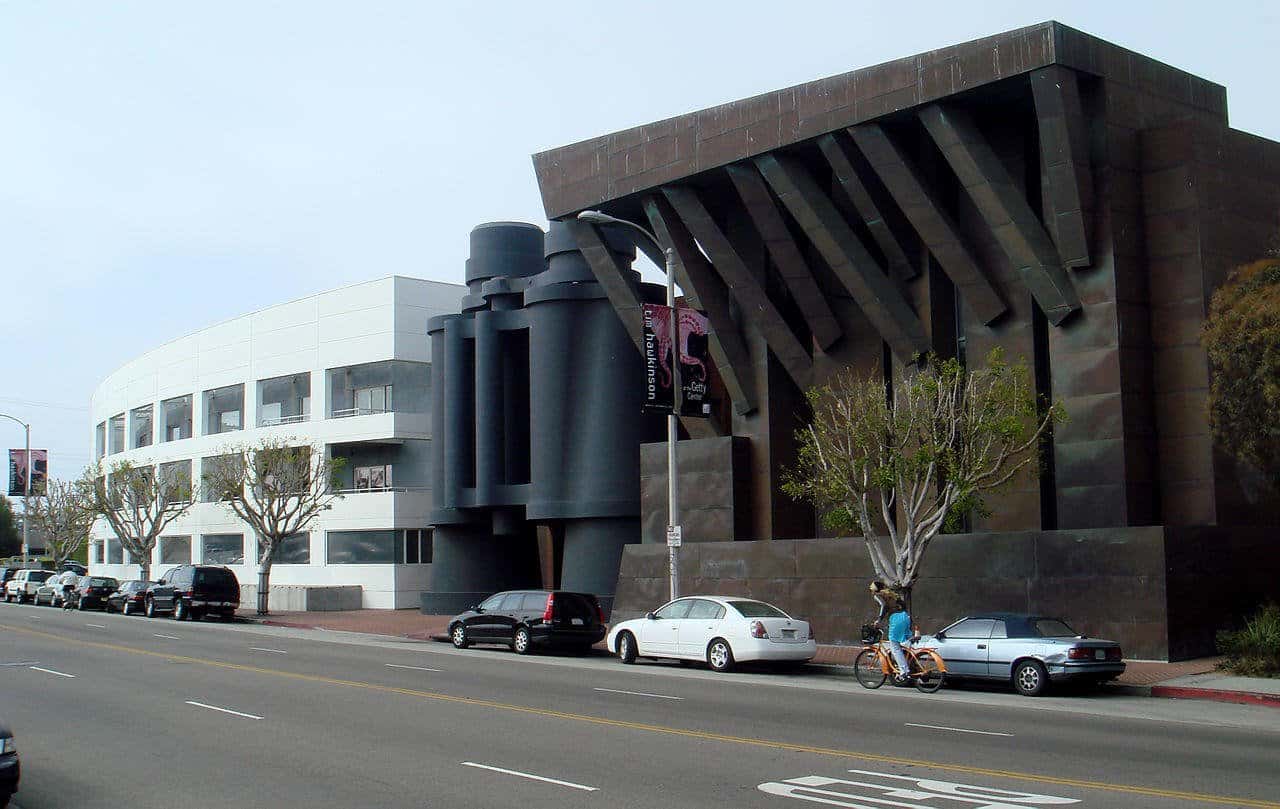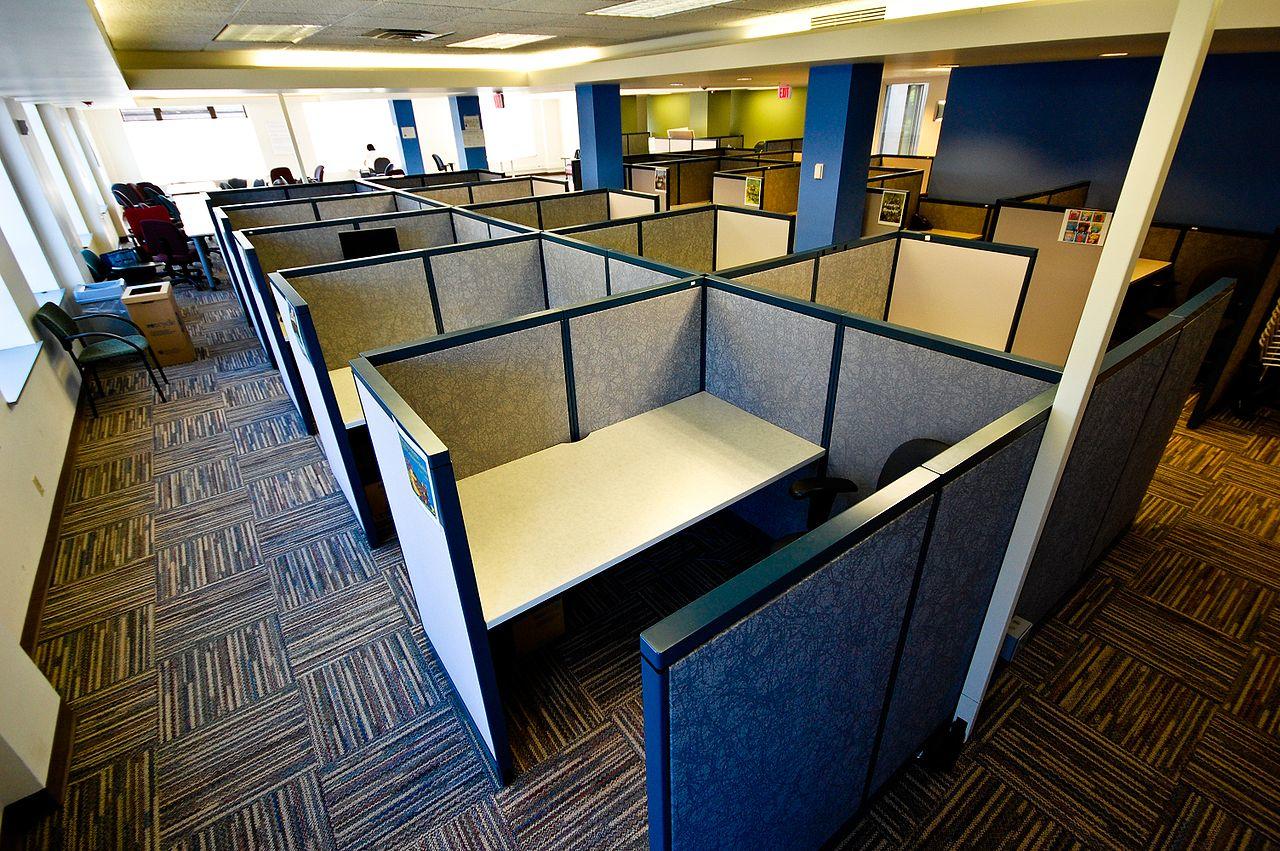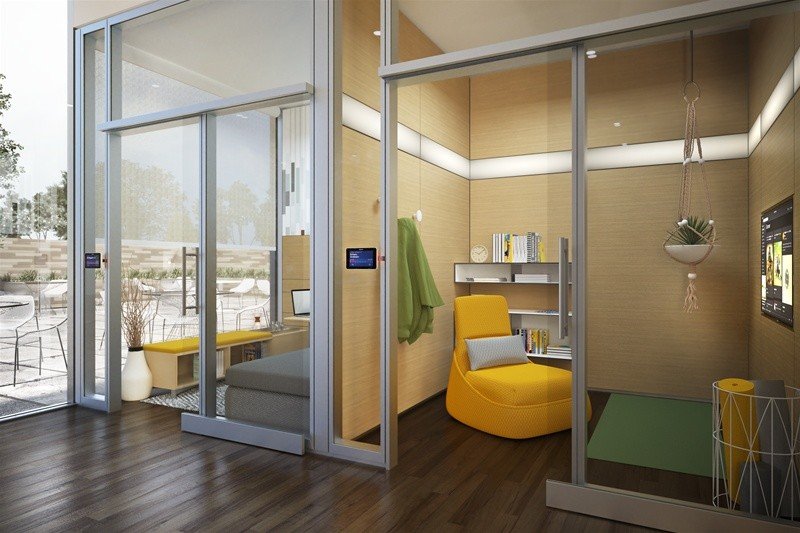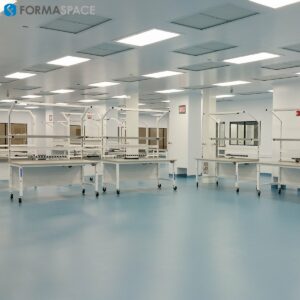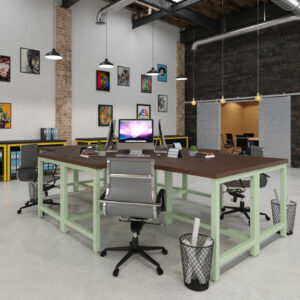Chris Andrews, Formaspace VP of Sales and Marketing, and Greg Casey, Formaspace VP of Engineering and Design, have just returned from the annual National Exposition of Contract Furnishing show — more commonly known as Neocon — which has been held each year since 1969 at the Merchandise Mart in Chicago.
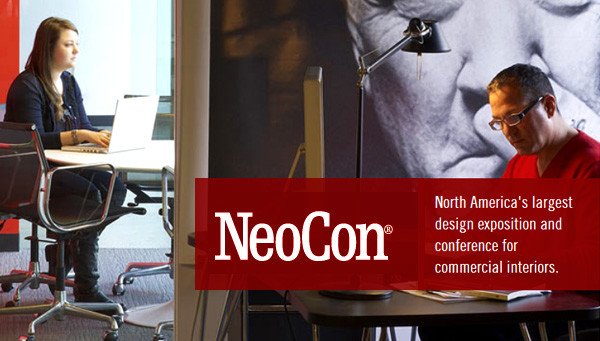
We asked Chris and Greg to weigh in on the top two office furniture design trends on display at Neocon:
-
The first trend Chris and Greg observed is a more nuanced, refined approach to promoting collaboration between employees in the office.
What’s new about this? The key breakthrough is designers have rediscovered the need for something we thought was lost forever: privacy in the workplace. We’ll take a deeper look how new designs on display at Neocon help bring back a bit of privacy in the work place in a moment.
-
The second trend Chris and Greg observed was broad promotion of health and well-being at the office, characterize by utilizing flexible, reconfigurable seating and moveable office furniture.
Neocon 2014 was chockablock full of moveable, reconfigurable seating and work tables that move with you as you change position or even furniture that reconfigures itself throughout the day to encourage (some might say force!) you to change your seating position or even to stand during part of the day. “Sitting still is the new smoking” is how Greg summed it up. We’ll take an in-depth look at this second trend — health and well-being at the office — in a future article.
But now we’d like to dive in more detail to the topic of privacy making its way back into office design.
A Brief History of Furniture Designed to Encourage Collaboration
The concept known as an ‘open office’ environment has been in the making for very long time. We can probably all picture in our minds classic 1950s pale sea-foam green metal desks laid out in a open bullpen environment. In the late 1960s, designer Robert Probst at Hermann Miller created the famed Action Office II line, which replaced those old heavy metal desks and partitions into semi-private, fabric covered cubicles, laid out in what would become pejoratively known as ‘cube farms’.
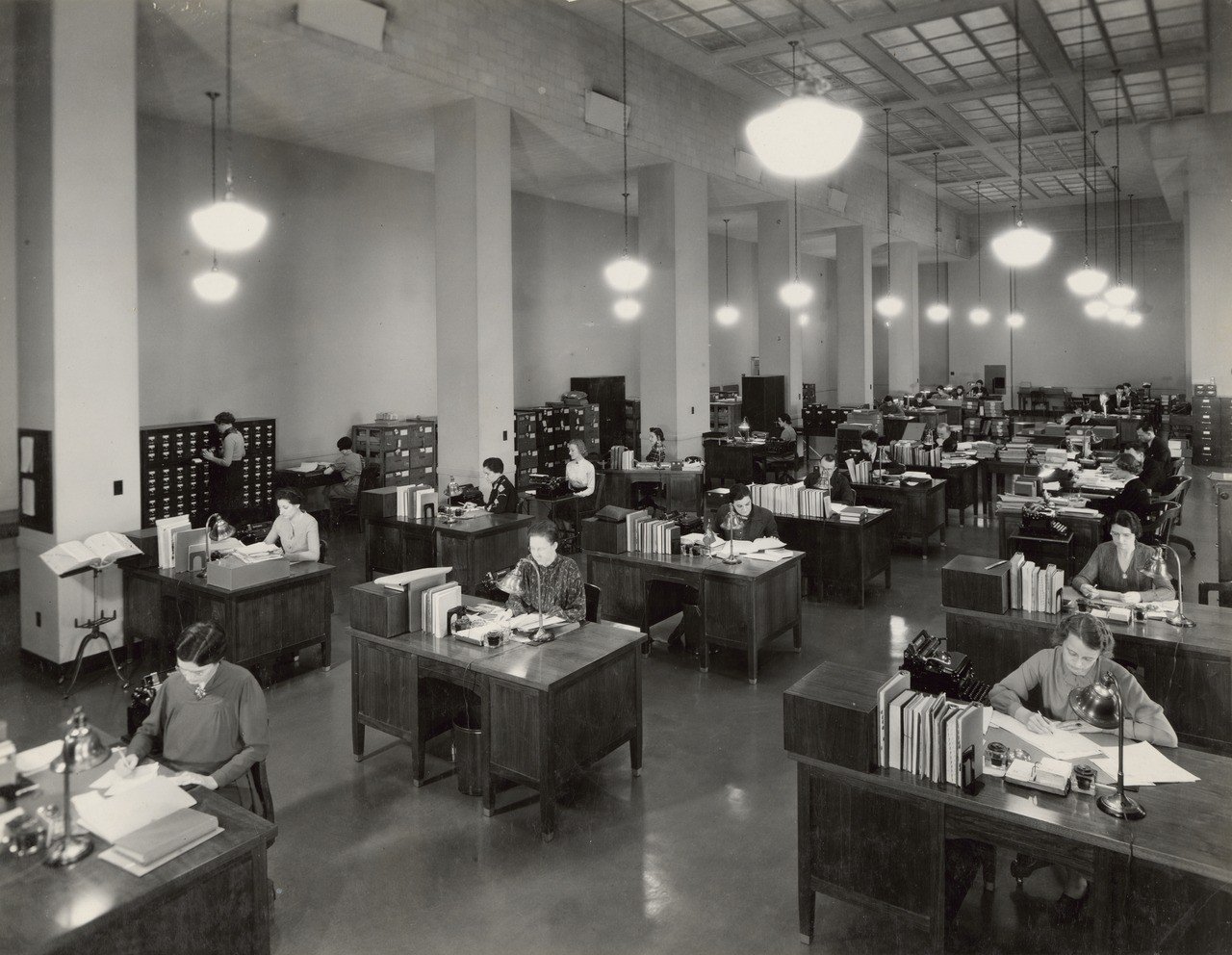
Wired magazine recently published a short history of the Action Office as an excerpt from of the new book Cubed: A Secret History of the Workplace by Nikal Saval. According to Saval, cubicles were seen as an improvement over the open bull-pen desk arrangements from previous years. Yet, as space planners started to look for ways to economize on real estate expenditures and began to shoehorn more and more cubicles into the same square footage, the appeal of ‘cubicle farms’ diminished. In some extreme cases, new employees needed to rely on fellow ‘Sherpas’ to walk them through these human rat mazes to find the restrooms!

A Bold Pair of Binoculars Starts the Collaborative Office Trend
The birth of the collaborative office design and interior layouts really got going during the heady dot-com boom days of the 1990’s in San Francisco and Silicon Valley and Los Angeles’ Silicon Beach (in Santa Monica/Venice).
The ground zero for collaboration in the office was the groundbreaking 1991 “Binoculars Building” designed by Frank Gehry for the famed advertising firm Chiat/Day. (The binoculars themselves were created by artists Claes Oldenburg and Coosje van Bruggen, they house tiny conference rooms as shown in the video below.)
This was a period when postmodernist design was on everyone’s mind, and this landmark building symbolized everything that was cool: it combined a breezy Southern California beach location with the creative work atmosphere of a top-notch ad agency. And not just any advertising agency. Chiat/Day was the very agency that produced the Apple 1984 advertisement, where a lone independent voice calls for escaping the drudgery of conformist cube culture (and communism and Microsoft to boot!)
Postscript: You probably won’t be surprised by the ironic twist of fate that Google now occupies the landmark Chiat/Day Binocular building. In this handheld video you can see the ad hoc Google furnishings set about like a college dorm room: drum set, video arcade games, pool table and other casual ‘fun’ interior design elements haphazardly placed in the entry space.
Race to Create Creative, Collaborative Working Environments
Throughout the 1990’s dot-com boom, architectural design firms like Gensler Associates and HOK successfully sold the proposition that if creative advertising agencies like Chiat/Day had playful work-spaces with casual areas promoting spontaneous encounters and collaborative work sessions, then C-Level Executives at other types of businesses should follow suit and invest in this type of office environment to spark more creativity and collaboration in their own workers.
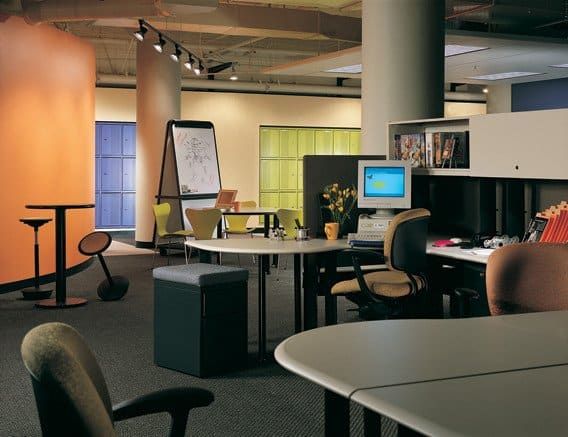
Collaborative Office Design Trend Takes on Laboratory Research Field
Over the last twenty years, this collaborative design trend has become a de facto standard in office layout and interior design for progressive companies, such as those in the media and communications, software and fashion industries. Chris recalls he first began to see this same collaborative design trend first making its way into the laboratory science and research markets about ten years ago.
At Neocon, Chris observed this developing trend in laboratory design has now fully taken root. Quite a few vendors exhibited laboratory office furniture designs and space layouts designed to encourage collaboration among researchers in different departments. The reasoning behind this may sound familiar — there’s a consensus around trying to reduce the ‘silo’ effect of isolated departmental functions which naturally occur in the laboratory research world and the desire to get researchers from different disciplines, such as chemistry and biology, to interact more with each other. We’ll be keeping an eye on this trend in a future update.
Complaints About Privacy in the Office: Building for a Long Time
Bubbling in the background have been some serious academic studies trying to quantify the effects a wholesale switch to an open office environment has on overall worker productivity. The University of Tennessee published a very influential study back in 1982, called Privacy Communication Open Plan Office, a Case Study.
Research study authors Sundstrom, Kring, Herbert and Brown investigated work environments where employees were transferred to new office environments: managers were moved from private walled offices to door-less enclosures, staff specialists gave up private double offices and moved into door-less enclosures, secretarial employees and supervisors vacated individual desks to work in ‘open office’ workspaces.
The conclusion?
Privacy was the main problem: No one felt secure in having a private conversation, as everything could be overheard by other employees. Researchers found this lack of privacy had a very negative impact on how workers were able to conduct their day-to-day job functions.
Another highly-cited study was published in 2009 by Finnish researchers Kaarlela-Tuomaala, Helenius, Keskinen and Hongisto. This study compared the productivity of professional workers by measuring their performance: first when they were located in individual private offices, and then a second time when they were relocated to open plan offices.
Researchers found that employees experienced increased concentration problems due to distractions and exhibited use of coping mechanisms to overcome problems caused by reduced privacy and higher noise levels. The study’s authors found that many of the goals for moving toward an open office plan, such as increased cooperation and collaboration, were not realized; instead, the research subjects found cooperation to be unpleasant in open office environments due to privacy concerns.
The Pendulum Swings Back: The Quiet Revolution — Brought to You by NPR and TED
Let’s fast forward back to the Neocon show held this past week in Chicago. In what may be one of the best marketing coups in the recent history office furniture design, Steelcase has rediscovered the concept of privacy and has introduced something that looks suspiciously like closed offices! What’s the backstory? It’s a quite serendipitous turn of events actually.
Back in 2012, Steelcase’s then president and COO Jim Keane was casually listening to an interview on NPR with author Susan Cain while he was out running some errands. Susan Cain, a former attorney, has captured the imagination of executives and human resource specialists with her 2012 book: Quiet: The Power of Introverts in a World That Can’t Stop Talking.
Keane and his fellow Steelcase executive, then CEO Jim Hackett (who is now president) were attending the upcoming 2013 TED Conference, where Susan was speaking. Here’s her TED Talk about how at least one third of workers are introverts, and they need quiet solitude to be creative.
Keane and Cain hit it off and launched a collaboration which was the talk of the Neocon show: Susan Cain Quiet Spaces by Steelcase. There are five designs in this series, all based on Steelcase’s well-received V.I.A. line introduced at the 2013 Necon show:
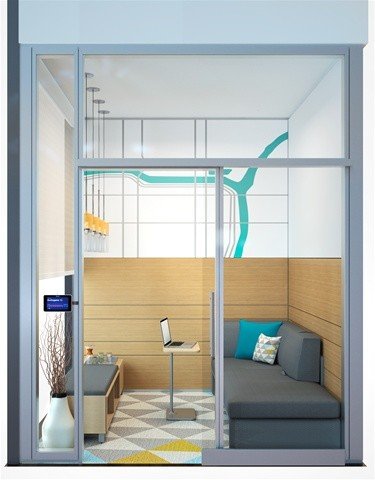
P.S. since we are being sensitive to different types of people, if you happen to be one who learns best by watching cartoons you’ll be happy to know Susan Cain’s book has been interpreted by cartoon notebook drawings by dwlFilms.
https://www.youtube.com/watch?v=74kBqeq__OQ
We’ll continue this series next week with more details about Susan Cain’s insight and what other contract office furniture manufacturers are doing to promote private areas in the modern office. Some of the designs are quite ingenious. In the meantime if you are contemplating a redesign of your office, Formaspace can be an invaluable resource. We can build unique custom furniture, such as large conference tables, computer workstations and workbenches that will give your office that ‘industrial design’ look that everyone wants. Give us a call at 800.251.1505 and we’ll be happy to exchange ideas and talk about how we can work together.


